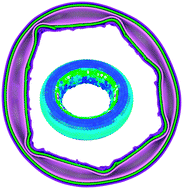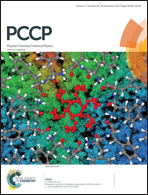Structural instability and mechanical properties of MoS2 toroidal nanostructures
Abstract
Molybdenum disulfide (MoS2) nanostructures have received considerable research attention due to their outstanding physical and chemical properties. Recently, a form of MoS2 ring structure exhibiting unique transport properties has been experimentally identified. Herein, we present the first report describing direct molecular dynamics (MD) simulations of structural instability and mechanical properties of hypothetical MoS2 nanotube (NT) toroidal nanostructures. Nanorings with small diameter MoS2 NTs retain their circular shape because of the higher bending stability of NTs, while for those with large diameter MoS2 NTs buckling/kinking and displacive phase transformations appear to effectively reduce bending stress as a mechanism for stabilizing the nanorings. However, the nanorings which have to polygonize maintain a circular shape as thick multi-walled inner nanorings are presented. Furthermore, mechanical responses of various nanoweaves (nanochains, nanomailles, and nanochainmailles) by linking nanorings together are also studied. The results show that Young's modulus, stretchability and tensile strength of such nanoweaves depend not only on the helicity of MoS2 NTs but also on the woven pattern. For example, nanostructures with 4-in-1 weaves of nanorings exhibit much higher tensile strength and stiffness but lower extensibility than those with 2-in-1 weaves. The finding suggests that MoS2 NT nanorings and their woven hierarchical structures may be used in the development of new flexible, light-weight electromechanical and optoelectronic nanodevices.


 Please wait while we load your content...
Please wait while we load your content...